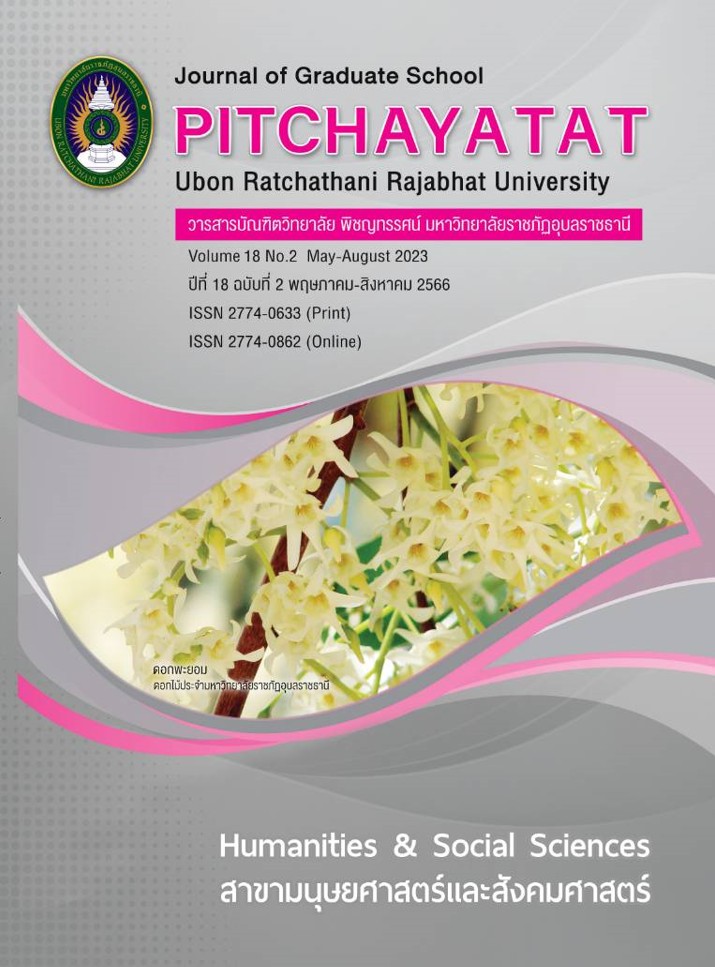การศึกษาปัจจัยสำคัญในการขับเคลื่อนนวัตกรรมการจัดการเรียนรู้ในพื้นที่ นวัตกรรมการจัดการศึกษาระดับจังหวัดศรีสะเกษ
คำสำคัญ:
ปัจจัยสำคัญในการขับเคลื่อนนวัตกรรม , การจัดการเรียนรู้ , พื้นที่นวัตกรรมการจัดการศึกษา , จังหวัดศรีสะเกษบทคัดย่อ
การวิจัยนี้มีวัตถุประสงค์เพื่อ 1) ศึกษาปัจจัยสำคัญในการขับเคลื่อนนวัตกรรมการจัดการเรียนรู้ในพื้นที่นวัตกรรมการจัดการศึกษาระดับจังหวัดศรีสะเกษ 2) ศึกษาความสัมพันธ์ระหว่างปัจจัยที่ส่งผลต่อในการขับเคลื่อนนวัตกรรมการจัดการเรียนรู้ในพื้นที่นวัตกรรมการจัดการศึกษาระดับจังหวัดศรีสะเกษ และ 3) แนวทางในการพัฒนาการขับเคลื่อนนวัตกรรมการจัดการเรียนรู้ในพื้นที่นวัตกรรมการจัดการศึกษาระดับจังหวัดศรีสะเกษ ตัวอย่างได้แก่ ผู้บริหาร และครูประกอบด้วย ผู้อำนวยการโรงเรียน รองผู้อำนวยการโรงเรียน ครูที่ปฏิบัติงาน กรรมการสถานศึกษา ผู้ปกครอง ของโรงเรียนที่ได้รับการนวัตกรรมการจัดการเรียนรู้จังหวัดศรีสะเกษ จำนวน 860 คน โดยเลือกแบบเจาะจง สถิติที่ใช้ ได้แก่ แบบสอบถามร้อยละ ค่าเฉลี่ย ส่วนเบี่ยงเบนมาตรฐาน การวิเคราะห์สมการถดถอยพหุคูณ
ผลการวิจัยพบว่า
- ปัจจัยสำคัญในการขับเคลื่อนนวัตกรรมการจัดการเรียนรู้ในพื้นที่นวัตกรรมการจัดการศึกษาระดับจังหวัดศรีสะเกษมีค่าเฉลี่ยมากที่สุด ได้แก่ ปัจจัยด้านวัฒนธรรมและบรรยากาศในการทำงาน มีค่าเฉลี่ยเท่ากับ 4.48 รองลงมาเป็นปัจจัยด้านการทำงานเป็นทีมมีค่าเฉลี่ยเท่ากับ 4.32 ส่วนปัจจัยด้านวัสดุสิ่งของและการเงินมีค่าเฉลี่ยต่ำสุด
- ความสัมพันธ์ระหว่างปัจจัยสำคัญในการขับเคลื่อนนวัตกรรมการจัดการเรียนรู้ในพื้นที่นวัตกรรมการจัดการศึกษาระดับจังหวัดศรีสะเกษตัวแปรที่เป็นปัจจัยสำคัญ มีเพียง 3 ตัวแปรเท่านั้นที่มีอิทธิพลมากที่สุดและส่งผลต่อความสำเร็จ ได้แก่ ตัวแปรภาวะผู้นำของผู้บริหาร ตัวแปรการทำงานเป็นทีม ตัวแปรวัฒนธรรมและบรรยากาศ ในการทำงาน อย่างมีนัยสำคัญทางสถิติที่ระดับ .05 ซึ่งสามารถเขียนสมการพยากรณ์ในรูปคะแนนดิบและคะแนนมาตรฐานตามลำดับ ดังนี้
สมการพยากรณ์
= 0.742 + 0.613X6 + 0.575X4 + 0.300X7
สมการคะแนนมาตรฐาน
= 0.193Z6 + 0.075Z4 + 0.057Z1
- แนวทางนโยบายเพื่อสนับสนุนปัจจัยด้านภาวะผู้นำของผู้บริหารให้เกิดกลไกการจัดการทั้งระบบ แนวทางเชิงนโยบายได้แก่ ปัจจัยที่ 1 แนวทางการส่งเสริมเชิงนโยบายที่สนับสนุนปัจจัยด้านภาวะผู้นำของผู้บริหารให้เกิดกลไกการจัดการทั้งระบบ ปัจจัยที่ 2 แนวทางส่งเสริมเชิงนโยบายที่สนับสนุนปัจจัยการทำงานเป็นทีม การทำงานแบบมีส่วนร่วมทุกภาคีภายในภายนอก ปัจจัยที่ 3 แนวทางส่งเสริมเชิงนโยบายที่สนับสนุนปัจจัยด้านวัฒนธรรม และบรรยากาศในการทำงานอบรมเชิงปฏิบัติการประจำปี เพื่อสร้างวัฒนธรรมองค์การแห่งการเรียนรู้และส่งเสริมการทำงานเชิงรุกขยายผลเครือข่ายแนวทางเชิงปฏิบัติการ ได้แก่ ปัจจัยที่ 1 แนวทางการส่งเสริมเชิงปฏิบัติการที่สนับสนุนปัจจัยด้านภาวะผู้นำของผู้บริหารควรส่งเสริมให้ความเน้นหนักใน ปัจจัยที่ 2 แนวทางการส่งเสริมเชิงปฏิบัติการ ในการทำงานเป็นทีมควรส่งเสริมให้ความเน้นหนักในปัจจัยที่ 3 แนวทางการส่งเสริมเชิงปฏิบัติการ ในด้านวัฒนธรรมและบรรยากาศในการทำงานควรส่งเสริมให้ความเน้นหนัก
เอกสารอ้างอิง
กิตติพร อาพา และคณะ. “ข้อเสนอเชิงนโยบายเพื่อพัฒนาความเป็นองค์กรนวัตกรรมของโรงเรียนมัธยมศึกษา ในจังหวัดขอนแก่น,” วารสารวิจัย มข. สาขามนุษยศาสตร์และสังคมศาสตร์ (ฉบับบัณฑิตศึกษา). 8, 3 (กันยายน-ธันวาคม 2563): 32-41.
ชลกร ตันประภัสร์, ธร สุนทรายุทธ และไพรัตน์ วงษ์นาม. “ปัจจัยที่ส่งผลต่อความคิดสร้างสรรค์และนวัตกรรมโรงเรียนเอกชนระดับการศึกษาขั้นพื้นฐาน,” วารสารการศึกษามหาวิทยาลัยบูรพา. 7, 2 (เมษายน-กันยายน 2556): 42-55.
ณัฐธิดา สุระเสนา. ความสัมพันธ์ระหว่างภาวะผู้นำของผู้บริหารโรงเรียนกับแรงจูงใจในการปฏิบัติงานของครูในสังกัดสำนักงานเขตพื้นที่การศึกษามัธยมศึกษา เขต 21. วิทยานิพนธ์ครุศาสตรมหาบัณฑิต มหาวิทยาลัยราชภัฏสกลนคร, 2564.
พระครูกิตติญาณวิสิฐ และคณะ. “แนวทางการพัฒนาพื้นที่นวัตกรรมทางการศึกษา,” วารสารศิลปะการจัดการ. 6, 2 (เมษายน-มิถุนายน 2565): 747-763.
วิวัฒน์ มีสุวรรณ์. “ปัจจัยที่ส่งผลต่อการสร้างสรรค์นวัตกรรมด้านสื่อการเรียนการสอนของครูในสถานศึกษาสำหรับปฏิบัติการสอน เครือข่ายมหาวิทยาลัยนเรศวร,” วารสารศึกษาศาสตร์ มหาวิทยาลัยนเรศวร, 22, 1 (มกราคม-มีนาคม 2563): 220-236.
วัลลภ บุตรเกตุ. วัฒนธรรมองค์การกับความสุขในการทำงานของครูในโรงเรียนสังกัดสำนักงานเขตพื้นที่การศึกษามัธยมศึกษา เขต 9. วิทยานิพนธ์ปริญญาศึกษาศาสตรมหาบัณฑิต มหาวิทยาลัยศิลปากร, 2562.
วราภรณ์ ช้างอยู่. ความสัมพันธ์ระหว่างภาวะผู้นำของผู้บริหารสถานศึกษากับความพึงพอใจในการปฏิบัติงานของครูผู้สอน สังกัดสำนักงานเขตพื้นที่การศึกษาประถมศึกษากรุงเทพมหานคร. วิทยานิพนธ์ศึกษาศาสตรมหาบัณฑิต มหาวิทยาลัยเทคโนโลยีราชมงคลธัญบุรี, 2557.
วรวิทย์ นิเทศศิลป์. สื่อและนวัตกรรมการเรียนรู้. ปทุมธานี: สกายบุ๊กส์, 2557.
สุนทร พลวงค์. การพัฒนาการทำงานเป็นกลุ่มของบุคลากรในสังกัดกองการศึกษา เทศบาลตำบลท่าสะอาด อำเภอเซกา จังหวัดหนองคาย. วิทยานิพนธ์ครุศาสตรมหาบัณฑิต มหาวิทยาลัยราชภัฏมหาสารคาม, 2551.
Tan, C.C. et al. “A Socio-Cognitive Structured Stimuli in Validating Students' Organistic States Represented by Self-Efficacy and Psychological Engagement for Career Search Self-Efficacy,” Review of International Geographical Education Online. 11, 1 (May 2021): 2163-2174.
ดาวน์โหลด
เผยแพร่แล้ว
รูปแบบการอ้างอิง
ฉบับ
ประเภทบทความ
สัญญาอนุญาต
ลิขสิทธิ์ (c) 2023 วารสารบัณฑิตวิทยาลัย พิชญทรรศน์ มหาวิทยาลัยราชภัฏอุบลราชธานี

อนุญาตภายใต้เงื่อนไข Creative Commons Attribution-NonCommercial-NoDerivatives 4.0 International License.
บทความทุกเรื่องได้รับการตรวจความถูกต้องทางวิชาการโดยผู้ทรงคุณวุฒิภายนอกอย่างน้อย 3 คน ความคิดเห็นในวารสารพิชญทรรศน์เป็นความคิดเห็นของผู้นิพนธ์มิใช่ความคิดเห็นของผู้จัดทำ จึงมิใช่ความรับผิดชอบของวารสารพิชญทรรศน์ และบทความในวารสารพิชญทรรศน์สงวนสิทธิ์ตามกฎหมายไทย การจะนำไปเผยแพร่ต้องได้รับอนุญาตเป็นลายลักษณ์อักษรจากกองบรรณาธิการ





